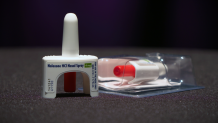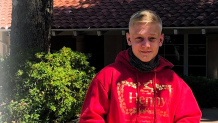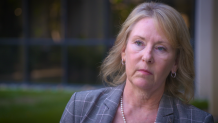California Superintendent of Education Tony Thurmond is taking action after an NBC Bay Area Investigation exposed a potential safety risk inside schools, threatening hundreds of thousands of students across the state.
In surveying the largest school districts in the Bay Area, the Investigative Unit discovered just how few schools are equipped with a free, live-saving tool that can successfully reverse the deadly effects of a drug overdose.
What that tells me is we've got a lot of work to do and we've got to work fast...this is a situation that has reached a crisis level.
Tony Thurmond, CA Superintendent of Education
“What that tells me is we've got a lot of work to do and we've got to work fast,” Thurmond said during an exclusive interview with NBC Bay Area. “This is a situation that has reached a crisis level.”
Thurmond is now calling on school districts across the state to take urgent action in getting staff the necessary training to be able to obtain and administer Narcan, also known as naloxone, which is a prescription medication designed to reverse the potentially fatal effects of a drug overdose.
“It doesn't make sense to me for anyone to say that there isn't a need for it,” Thurmond said. “Drugs have always posed a serious threat to teenagers, but I think we're seeing risks now that are at a crisis level and are at a level that we haven't seen before.”
Among Largest Bay Area School Districts, Only One Has Life-Saving Drug to Prevent Fatal Overdoses
The 10 largest school districts across the 9-county Bay Area are home to roughly 500 public schools and 320,000 students. The NBC Bay Area Investigative Unit surveyed each of those school districts to find out which have made naloxone available on campus, a life-saving medication that can prevent the deadly effects of a drug overdose from opioids such as heroin and fentanyl.
Source: NBC Bay Area Investigation
Credit: Andrew Williams / NBC
Drug Overdoses Have Killed 500,000+ Since 2000
Drug overdoses in the U.S. have claimed the lives of more than 500,000 people over the past two decades, according to the Congressional Budget Office.
To better understand the impact on teenage victims, the Investigative Unit obtained and analyzed data from the Centers for Disease Control and Prevention, and learned California recently suffered the largest spike in teen deaths across the county – up 158 percent in 2020 for a total of 299 teenage deaths. California far surpassed every other state in the number of overdose-related teenage deaths. Texas suffered the second highest death toll with 117 deaths, followed by Arizona with 112.

Life-Saving Drug has 50-Year-Record of Reversing Overdoses
The nasal spray has been proven to revive those who are unconscious within just a matter of minutes and does not prove harmful even when given to someone who may not be suffering from a drug overdose.
The Food and Drug Administration first approved its use to treat overdoses more than 50 years ago.
In California, the state legislature gave schools the legal authority to obtain and administer naloxone in 2017. Assembly Bill 1748 granted that permission, so long as school staff undergo training on how to properly use the medication. Thurmond, who was a state lawmaker at the time, was one of the first politicians to vote in favor of the measure as a member of the Assembly’s Education Committee. While he later voted against a revised version of the legislation, Thurmond says he ultimately supported the now, current version of the law, even though he was not present during the final vote in the Assembly.

The Antidote is Free, So Why Isn’t It on Every School Campus?
For the past four years, California’s Department of Health Care Services, has been running the Naloxone Distribution Project, which continues to offer free naloxone kits to schools all across the state, but an NBC Bay Area investigation has revealed a lack of school participation in the program. This year alone, the project received more than $50 million in taxpayer funds, and, to date, has distributed a total of 1.5 million units of naloxone to entities such as libraries, law enforcement agencies, criminal justice organizations, and public health agencies. Schools, however, make up just 2 percent of that distribution, according to data received from DHCS.
Overdose Deaths Across Bay Area
Hover over the map to learn the total number of overdose deaths and death rates for each of the Bay Area's 9 counties during 2021.
Note: Figures include overdose deaths involving opioids such as prescription pain relievers (i.e. hydrocodone, oxycodone and morphine), heroin, and opium. Deaths related to chronic drug use are excluded.
Source: California Dept. of Health
Credit: Amy O'Kruk / NBC
Largest School Districts Fail to Stock Live-Saving Tool
To learn more, the Investigative Unit surveyed the 10 largest school districts in the Bay Area, home to nearly 500 schools and 320,000 students. The survey revealed students at 40 percent of those school districts have experienced a nonfatal drug overdose over the past six years. Despite the prevalence of drugs, NBC Bay Area learned only one of the 10 districts currently has naloxone available and ready to administer to students during an emergency. Since April, East Side Union High School District has had naloxone at all 16 of its high schools. In examining the Bay Area’s 10 largest school districts, the Investigative Unit learned that naloxone is only available at 3 percent of high schools and zero middle and elementary schools.
“You need to be unified to be able to turn this crisis around,” said Jan Blom, who lost his 17-year-old son to a drug overdose in July 2020. “We need the school system to be part of this.”
His son, Linus Blom, was fluent in Finnish, Swedish, and English, and a top wrestler as a junior at Los Gatos High School, but just a few weeks before beginning his senior year, his family found him unconscious at home.
“The paramedics tried to resuscitate him and they worked on him for a while,” he said. “There was nothing that could be done.”

Linus overdosed on what he thought was a prescription pain pill he bought off the internet. He had no idea it was laced with a much more powerful drug – fentanyl, which has become increasingly popular in the illegal drug marker since it’s cheap to produce and up 100 times more potent than morphine.
After his son’s overdose, he read through his son’s social media accounts and learned much of his drug use took place at school.
“For us, the worst thing happened,” said Blom. “I do hope, sincerely, that we can prevent further loss.
Blom is now on a volunteer task force in Santa Clara County that aims to raise awareness about the dangers of fentanyl and potential solutions, like stocking naloxone on school campuses.
In the event of an emergency, that life-saving drug is going to be urgently needed.
Dr. Mary Ann Dewan, Santa Clara County Office of Education Superintendent
“In the event of an emergency, that life-saving drug is going to be urgently needed,” said Dr. Mary Ann Dewan, superintendent of schools for the Santa Clara County Office of Education.
“It doesn't seem like there's a united effort to actually prevent students from dying,” said Senior Investigative Reporter Bigad Shaban.
“That's the point of our project,” Dewan replied.

Dr. Mary Ann Dewan is the superintendent of the Santa Clara County Office of Education
She and her colleagues are working to outfit every school in her region with naloxone by the end of the year. While she says no student has ever died of an overdose inside any of her schools, the risk is growing, she says, and ignoring it could prove fatal.
“We rarely have a heart attack on a school campus, but we have the defibrillator in the event that we need it,” Dewan said. “We rarely have allergic reactions, but we have the EpiPen. There's no better time to prepare for an emergency than before the emergency happens.
In Los Angeles, just within a matter of weeks, seven students recently overdosed – including 15 year-old Melanie Ramos, who was found dead inside her high school bathroom last month. One week later, the Los Angeles Unified School District announced it would make Naloxone available at all of its schools, kindergarten through 12th grade, by the end of the month.
“If schools are waiting for their kids to get hurt, isn't that too late,” Shaban asked.
“Well, I don't think it's a question that schools are waiting for kids to get hurt – I think schools are trying to catch up,” Thurmond replied. “I just think schools have been dealing with a great deal, many things. I don't think that they're waiting, but they're learning.”
After Thurmond sat down with NBC Bay Area, his office said it immediately began the process of personally contacting each of the school districts surveyed by the Investigative Unit in an effort to encourage those districts to make naloxone available at their campuses.
“While a school focus really should be on how we educate our kids, we cannot ignore the level of intensity that fentanyl has represented for California students and students across the country,” Thurmond said. “This is something that can save lives.”
On Thursday, Thurmond also sent a letter to each of California’s roughly 1,000 school districts, urging them to take "immediate steps" to educate students, staff, and families about the growing threat of fentanyl, as well as potential life-saving solutions, such as obtaining free naloxone kits and training the appropriate staff to administer the life-saving drug in the event of an emergency.
"Most of our young victims ingested fentanyl accidentally, thinking they were using something less dangerous," Thurmond wrote in the letter. "Teens never know what they are getting. One pill can kill them."

